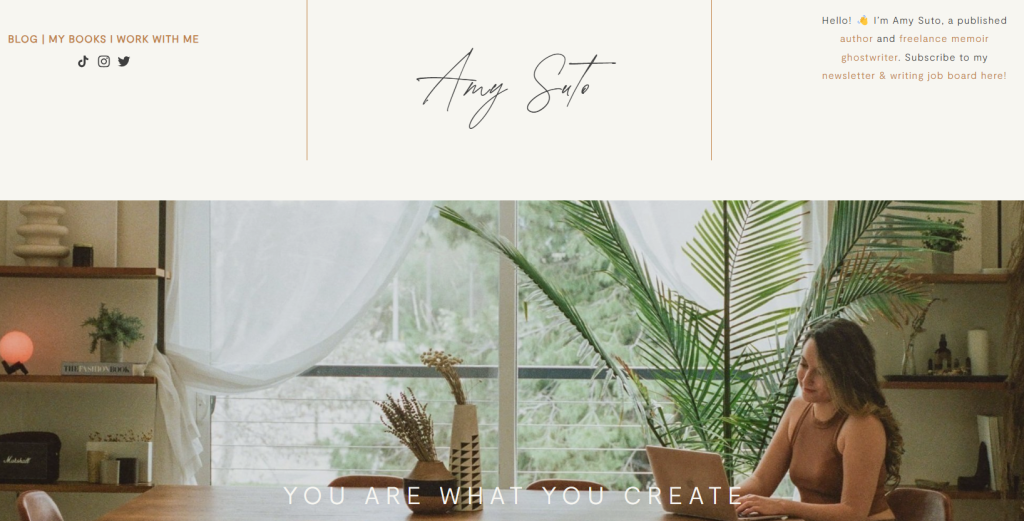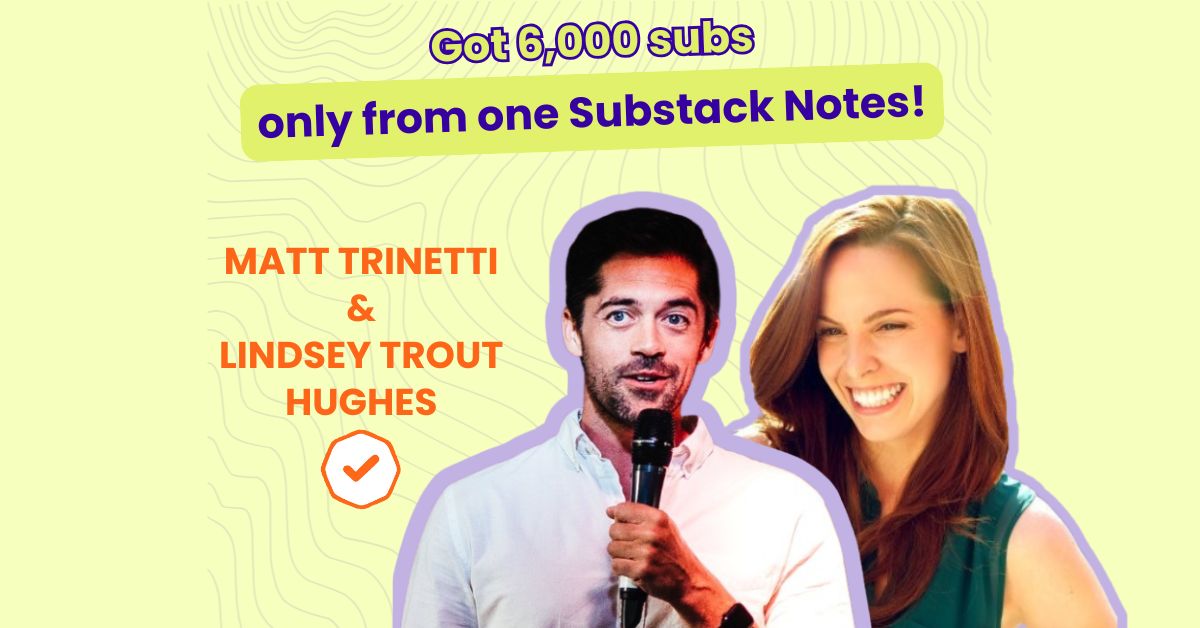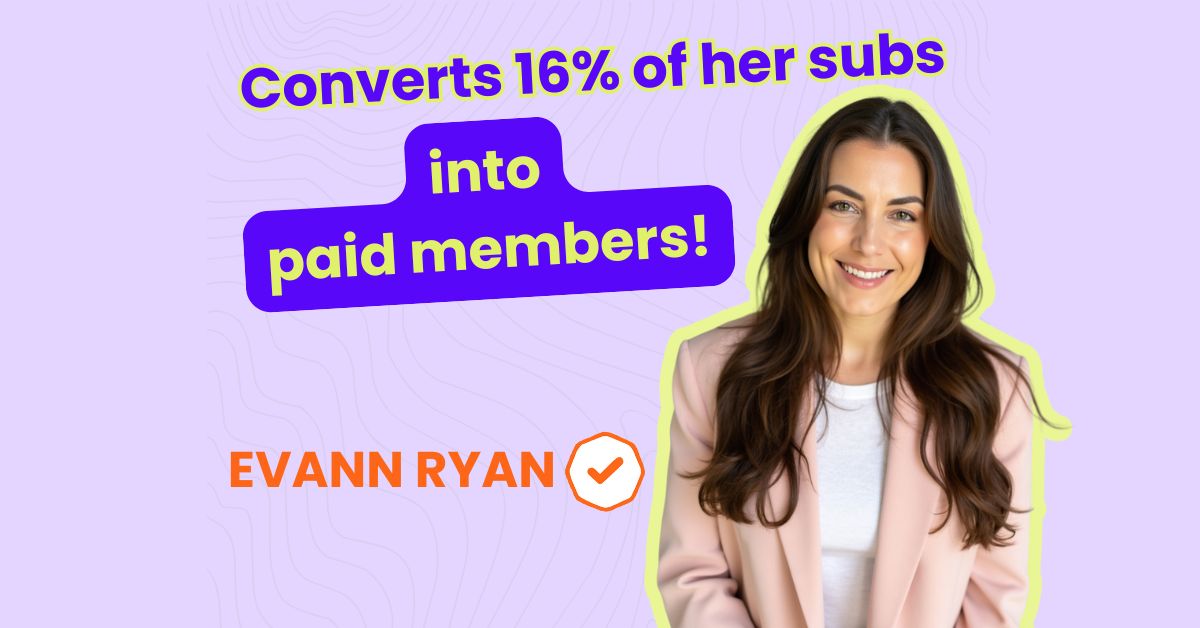Interview Date: March 30, 2025
Table of Content
- Meet Amy Suto
- Newsletter Identity Card
- Tools she uses to run her newsletter
- How she started her newsletter
- How she grew over 7,400 subcribers
- Her paid subscription strategies to become a Substack bestseller
- Personal & professional impact of running a newsletter
MEET THE CREATOR
Amy Suto is a former Hollywood TV writer who turned into a digital nomad. For the past four years, she’s traveled the world while building a successful career as a writer. As a published author of three books, including Six-Figure Freelance Writer: A Holistic Guide on Finding Freedom in Freelancing, Amy has shown others how to carve their own path in the writing world.
Additionally, she runs From the Desk of Amy Suto: Make Writing Your Job newsletter on Substack, where she writes about how to write professionally that also includes freelance writing job listings and other great (paid!) writing opportunities for creatives, freelancers, and book professionals.
Even though she started her newsletter journey less than two years ago, she has already become a Substack bestseller, reaching over 7,400 free subscribers and hundreds of paid members!
In this interview, we’ll dive into:
- Why she added a newsletter to her content funnel, alongside five other social media platforms with 50K+ followers
- How she converted followers from her social media platforms to grow her subscriber base to over 7,400
- How she achieved Substack bestseller status in less than two years
- Her newsletter’s contribution to her 6-figure writing career as a monetization channel
Enjoy!
NEWSLETTER IDENTITY CARD

TOOL STACK
START
You are a 6-figure freelance writer and an author of many books. How and why did you start From the Desk of Amy Suto: Make Writing Your Job in the first place? (see here)
I started my Substack to document what I’ve learned when it comes to building a sustainable writing career. Making writing your job is hard! And complicated! And everyone is really opaque about what works — and what doesn’t. That’s part of the reason that I wanted to pull back the curtain on a few different elements of what it means to be a professional writer.
I also wanted a place to share the job opportunities that were coming across my plate that I wasn’t taking because I was too busy to accept more clients, and so the job board was born out of that overflow.

GROWTH
You grew your subscriber number from 0 to 7,400 in less than 2 years. This is impressive. Which strategies did you use to grow over 7,400 subscribers?
0 – 500 Subscribers
Before I moved to Substack, I had about ~ 500-ish subscribers on my email list that I had captured from my blog. These subscribers signed up and received my weekly newsletter back when I was using ConvertKit, and they were sitting on my list for about two years. I barely posted at this point (maybe once a month or every six months!) so I wasn’t being consistent yet.

500 – 1,000 Subscribers
After I moved over to Substack, I finally got consistent. I publish every week (often multiple times per week these days!) and haven’t missed a week since I started. I grew from 600-1,000 subscribers fairly quickly with consistent effort, but it took some time for me to hone the topics and messaging of my Substack.
1,000 – 5,000 Subscribers
When I finally got clear on the value proposition of my Substack — helping writers get paid for their work through holistic strategies and clear paths to writing jobs! — I grew very quickly.
Recommendations on Substack, highlights in other writers’ Substacks, and shares on social media were key here.
5,000+ Subscribers
I’m currently focusing on serving my existing subscriber base with topics that I hope they’ll find valuable.
I have an “antifragile” approach to growth: if my readers are getting value from what I’m posting, they’ll stay. If they aren’t, then they’ll leave — and that’s okay! It just means I’m finding my true fans faster and really focusing on how I can best serve those true fans.
You have over 46,000 followers on TikTok (see here) and an additional 10,000 across other social media platforms. How have these channels contributed to your newsletter growth, and which one has been most effective in attracting new subscribers?
TikTok didn’t help me ~ whatsoever ~ in any of my marketing efforts. I grew fast there, but the retention and view counts stayed low as I don’t like posting-short form videos every day, which hurt me on that platform.
LinkedIn has been one of the better social media channels, and Substack Notes and Instagram Threads have given me the best boosts. But SEO (traffic from search engines) has been pretty massive as well.
I share the same posts across LinkedIn, Substack Notes, and Instagram Threads. Every time I post something on my Substack, I share a short written summary and repost it everywhere.
Other than that, I don’t share much else other than some occasional posts about what I’m up to or my philosophies on writing. Every newsletter writer has to decide in what ways they can show up authentically on social media, and that varies depending on your content and your story.
Regarding growth efforts, what would you do differently if you had a chance to start over?
I wouldn’t do anything differently. Exploring what you like to write (and what your audience wants to read!) takes time and experimentation, and it’s a gradual process to find that “product-market fit” as they say in the tech world.
These days, I understand how important it is to consider elements such as branding, marketing, and listening to your audience, so these types of things will guide me moving forward when I think about how best to help my audience of writers.
But at the end of the day, you have to enjoy what you’re writing each week! If you don’t, it shows in the finished product.
MONETIZATION
How long did it take for you to become a Bestseller?
It took me about a year and a half-ish to become a bestseller on Substack, and now I’m proud to say that I’m a top 50 publication in the Literature category! It’s been such a gift to see my work connect with writers who are building their businesses, so I’m happy to have found the right niche for the value I’m able to offer.
When did you launch your paid subscription, and how did you decide that it was the right time for you to activate it?
I launched paid subscriptions from day one after launching my Substack, and that’s the best way to do it. I think I got my first paid subscriber pretty quickly after launching — maybe a week or two after my first post?
I also have a hunch that the Substack algorithm really boosts publications who have the paywall turned on because that’s how they make money, after all. So I think it’s smart to launch paid subscriptions from the jump, but you can only paywall your archives so all of your posts start off as being free initially, or you can just paywall the comments section.
There are a lot of options for giving subscribers a chance to get to know you before they support your work.
How did you gain your first 10 paid subscribers?
I stayed consistent: I hit my publishing schedule each week, shared each post on social media, and grew my paid subscribers one post at a time!
What are your strategies to convert free subscribers into paid ones or gain new paid subscribers? Which strategy you’ve tried worked best?
When I started the writing job board, I realized how time-intensive it was to curate all of the writing jobs and help my incoming clients find the best candidates for them. Because of that, I decided to paywall all of the writing job board posts, with the featured jobs going wide after 48 hours.
This may seem like a pretty strict paywall for some people, but I’ve set up a system that allows me to make running my Substack sustainable, and I think $8 per month is a pretty fair rate to pay for the curation of dozens of writing jobs per week — delivered straight to your inbox. And if someone doesn’t think that’s fair, it’s all good!
There are plenty of other ways people can find writing jobs out there, but I’ve taken on the time-intensive burden of trying to round up all of the higher-paying opportunities in one place for my subscribers so they don’t have to do the legwork of finding the best stuff.
Ultimately, everyone who runs a newsletter should be offering a service that makes their readers’ lives better. You should save their money and time, or give them something special.
How did you decide what to offer differently to paid subscribers to make it compelling for them to join as paid members?
The writing job board will always be behind some kind of paywall to some extent, but my Sunday educational posts are free for all of my subscribers. That way, new subscribers can get to know me before they decide to upgrade my subscription.
I also have free trials turned on, so new subscribers can get a 7-day free trial to check out the job board and see if it’s right for them.

What are your biggest lessons from running a successful paid subscription?
It’s all about giving your subscribers the value they’re looking for and solving a problem for them.
What can you give someone that they’d be willing to pay for? I find it helpful to do an audit of all of the newsletters you pay for. Why do you pay for them? What unique value do they add to your life?
If you don’t pay for any newsletters, it will be challenging for you to understand how to run one. That’s why I recommend becoming a paid subscriber to at least 5-10 publications so you can understand how other successful newsletters bring value to their readers, and then see which ones you decide to keep and which ones you unsubscribe from.
IMPACT & LEARNINGS
How did building From the Desk of Amy Suto: Make Writing Your Job newsletter contribute to your life professionally and personally?
I’ve loved getting to know my readers! I’ve even met some subscribers in person in places like Argentina, and it’s so cool to continue to expand my writing community and help others make writing their job.
What would you do differently if you had a chance to start over From the Desk of Amy Suto: Make Writing Your Job?
I’m really happy with the evolution of my publication, so I wouldn’t do anything differently. I think every newsletter evolves over time, and I wouldn’t trade that evolution for anything.
What would it be if you had the right to give one piece of advice to aspiring newsletter creators?
Write what you love, but listen to your readers. Try and find that intersection of what you love writing about and what your audience loves reading!
Don’t take marketing for granted: understand how to get your writing out there. If you do, you’ll be unstoppable.
3 Popular From the Desk of Amy Suto: Make Writing Your Job Issues
- How to Become a Six-Figure Writer in 2025
- Deep Work as a Building Block to Success
- How to Calculate Your Hourly Rate as a Freelance Writer


